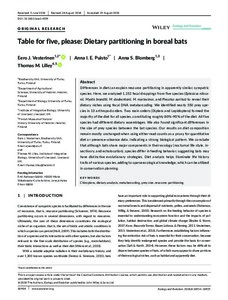Table for five, please: Dietary partitioning in boreal bats
Vesterinen Eero J.; Puisto Anna I.E.; Blomberg Anna S.; Lilley Thomas M.
https://urn.fi/URN:NBN:fi-fe2021042720025
Tiivistelmä
Differences in diet can explain resource partitioning in
apparently similar, sympatric species. Here, we analyzed 1,252 fecal
droppings from five species (Eptesicus nilssonii, Myotis brandtii, M. daubentonii, M. mystacinus, and Plecotus auritus)
to reveal their dietary niches using fecal DNA metabarcoding. We
identified nearly 550 prey species in 13 arthropod orders. Two main
orders (Diptera and Lepidoptera) formed the majority of the diet for all
species, constituting roughly 80%–90% of the diet. All five species had
different dietary assemblages. We also found significant differences in
the size of prey species between the bat species. Our results on diet
composition remain mostly unchanged when using either read counts as a
proxy for quantitative diet or presence–absence data, indicating a
strong biological pattern. We conclude that although bats share major
components in their ecology (nocturnal life style, insectivory, and
echolocation), species differ in feeding behavior, suggesting bats may
have distinctive evolutionary strategies. Diet analysis helps illuminate
life history traits of various species, adding to sparse ecological
knowledge, which can be utilized in conservation planning.
Kokoelmat
- Rinnakkaistallenteet [27094]
